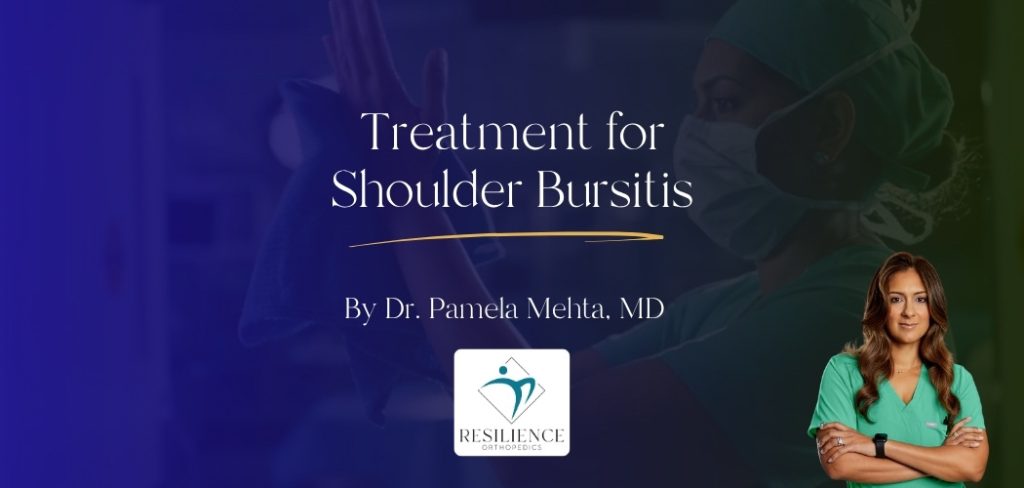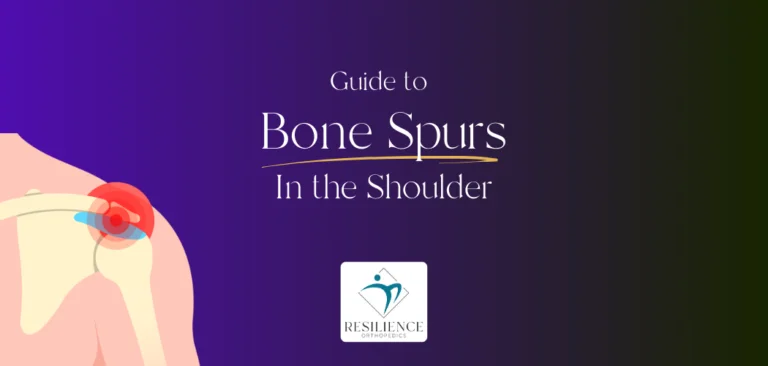Table of Contents
Shoulder bursitis occurs when the small, fluid-filled cushions (bursae) in your shoulder joint become inflamed. This may cause pain, stiffness, and swelling when you try to lift your arm or lie on your side.
Living with shoulder bursitis may affect your day-to-day activities. Even getting dressed or having a good night’s sleep can be challenging. But with rest, guided exercises, and expert care, you can return to your normal life.
If shoulder pain puts your life on pause, it might be time to consult a specialist and take the first step towards healing.
At Resilience Orthopedics in San Jose, Dr. Pamela Mehta helps you find lasting relief from shoulder and joint pain.
Key Takeaways
- Shoulder bursitis is the inflammation of the small fluid-filled sac in the shoulder.
- It may cause pain and stiffness, often from overuse or repetitive movements.
- Early diagnosis and treatment may prevent long-term mobility issues.
- Treatment options include rest, ice, physical therapy, and cortisone injections.
- Surgery is rarely needed, but an expert evaluation can help you make the right choice.
- Adjusting posture and strength exercises may help prevent recurrence
What’s Really Happening Inside the Shoulder?
Your shoulder is designed for movement. But it’s also a tight space where muscles, tendons, and the bursa work closely together. The bursa acts like a cushion, helping everything glide smoothly when you move your arm.
With shoulder bursitis, that cushion gets irritated. It swells and fills with extra fluid from overuse, pressure, or injury. Even simple movements may start to feel sharp, stiff, or painful.
Overhead sports compress the “subacromial space” (a narrow space that contains bursa and tendons), increasing the friction in your bursa.
Often, the problem starts slowly. Long hours at a desk, sports like tennis, or weekend hikes may add stress. Over time, this repeated strain inflames the bursa and makes everyday movement uncomfortable.

Key Symptoms of Shoulder Bursitis
Shoulder bursitis can feel different for everyone, but certain symptoms often appear together. Recognizing them early can help you get the right care before the problem worsens.
Pain-Related Symptoms
- Aching or throbbing pain, even at rest
- Sharp pain when lifting or reaching overhead
- Pain that worsens when lying on the affected side
- Tenderness over the outer shoulder
Mobility and Strength Issues
- Stiffness or a “tight” feeling in the joint
- Limited range of motion when raising or rotating your arm
- Muscle weakness around the shoulder
- Difficulty with daily tasks like dressing or reaching for items
Other Signs to Watch For
- Swelling or puffiness around the joint
- Redness or warmth in the shoulder
- A popping, cracking, or grinding feeling during movement
These symptoms may sometimes feel like other shoulder issues, such as rotator cuff or tendonitis. That’s why it’s important to get the right diagnosis.
How Shoulder Bursitis Progresses
Shoulder bursitis doesn’t always come on suddenly. At first, it may feel like a small ache or stiffness that comes and goes.
But over time, the pain can grow and start to interfere with your daily life.
Here’s how it usually progresses:
Mild Stage
You might feel a slight ache after using your arm. The shoulder may feel stiff, especially in the morning or after rest. You can still do most things, but it doesn’t feel right.
Moderate Stage
Pain becomes more frequent. Even small movements may cause discomfort. Lifting, reaching, or lying on that side may hurt. The shoulder often looks swollen and feels tender.
Severe Stage
Pain is constant, even when you’re not moving. The shoulder might look swollen, feel warm, and lose strength. Even everyday tasks become difficult.
When to See a Specialist
If the pain lasts more than a week or two, even with rest and home care, don’t wait. Early treatment can help alleviate symptoms and prevent long-term damage to your shoulder.
Book a Consultation with Dr. Pamela Mehta, MD
The Best Orthopedic Surgeon in San Jose
Dr. Mehta is a board-certified orthopedic surgeon who can help you recover from your joint condition. If you:
- Are Suffering From Pain and Mobility Issues
- Need Orthopedic Assessment and Advice
- Want Treatment From a Top Orthopedic Doctor
We Can Help
Causes of Shoulder Bursitis
Everyday Strain and Overuse
- Repetitive shoulder use during tennis, swimming, and weightlifting may overwork it.
- Jobs like painting, construction, or warehouse work often strain the shoulder.
- Sitting hunched over for hours strains your shoulders.
- A fall, bump, or sudden injury may inflame the bursa.
Age and Joint Changes
As we get older, natural wear and tear in the shoulder can make bursitis more likely:
- Bone spurs or joint changes press on the bursa and cause pain.
- Calcium deposits may irritate nearby tissue and cause inflammation.
- As you age, tendons can wear down and change how your shoulder moves. This adds pressure on the bursa and may cause irritation.
Less Common Medical Causes
- Though rare, a bacterial infection may inflame the bursa. This type of bursitis is serious. It often comes with fever or a general feeling of illness.

What Else Could Be Causing Your Shoulder Pain?
Shoulder pain can be frustrating and hard to figure out. That’s because the shoulder is a complex joint. It’s made up of muscles, tendons, ligaments, and bursae.
When any of them are injured or inflamed, it may cause:
- Rotator cuff tears
- Shoulder Impingement syndrome
- Frozen shoulder
- Shoulder dislocation
- Bicep tendonitis
These conditions often start with symptoms that look a lot like shoulder bursitis. To help you tell them apart, here’s a simple breakdown:
| Condition | How it happens | Movement Limitation | Onset | What sets it apart |
| Shoulder Bursitis | Bursa gets inflamed from overuse, injury, or pressure | Pain at certain angles, but movement still possible | Sudden or gradual | Swelling and tenderness over the outer shoulder |
| Shoulder Impingement | Tendons or bursae get pinched with movement | Pain when lifting the arm above shoulder height | Gradual, worse with use | Sharp pain with overhead movement that eases when resting |
| Rotator Cuff Tear | Tendon tears from injury or wear | Weakness when lifting or rotating the arm | Sudden or slow | Loss of strength is more noticeable than stiffness |
| Frozen Shoulder | The shoulder capsule becomes tight and thick | Stiff in all directions | Slow, often over months | Stiffness is worse than pain |
| Biceps Tendonitis | The biceps tendon gets inflamed from strain or overuse | Pain when lifting or turning the forearm | Gradual | Tenderness in the front of the shoulder |
| Shoulder Dislocation | The joint is forced out of place | Severe loss of movement and control | Sudden and intense | Noticeable deformity, strong pain, and sometimes numbness |
Every shoulder issue is different, and each needs the right care. Without proper diagnosis, the problem may get worse and cause lasting damage.
When Should You See A Doctor?
Mild shoulder pain often improves with simple home care. Here are a few steps that may help ease discomfort and support healing:
- Avoid overhead or repetitive arm movements.
- To reduce swelling, use an ice pack for 15–20 minutes, 2–3 times daily.
- Take over-the-counter pain relievers like ibuprofen or acetaminophen.
- Do gentle shoulder stretches if they don’t increase pain.
- Adjust your posture or workstation if sitting or screen time worsens the pain.
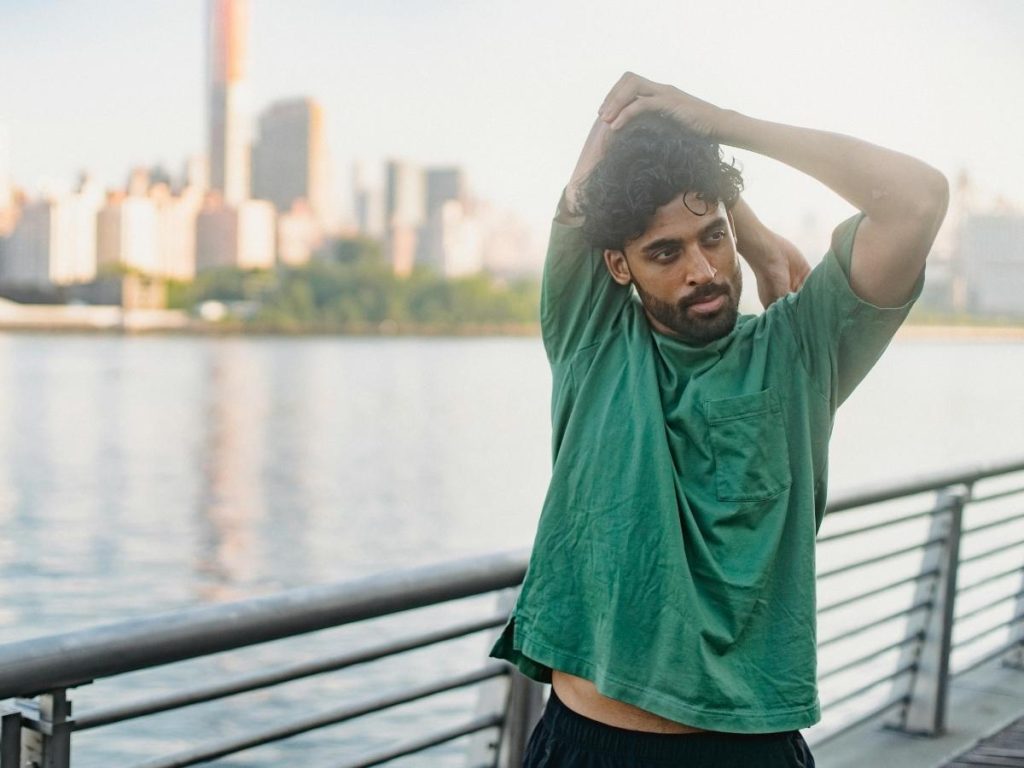
It’s a good idea to see a specialist if:
- The pain doesn’t improve after a few days of rest.
- You can’t move your shoulder without discomfort.
- Everyday tasks like dressing, working, or sleeping become hard.
Many people delay care in busy places like San Jose. With packed schedules and remote work, it’s easy to hope the pain will go away.
But without proper treatment, inflammation can build up and limit your shoulder’s movement over time.
Getting a clear diagnosis early means you can start the right treatment sooner. This helps you heal faster and return to daily life with less pain.
Diagnosis and What To Expect at Resilience Orthopedics
At Resilience Orthopedics in San Jose, I provide one-on-one care to find the source of your shoulder pain, not just treat the symptoms. Your first visit begins with a consultation.
I’ll start by listening closely to your symptoms and asking about your daily routine. Here’s what you can expect after that:
- A hands-on exam to check movement and pain points
- Imaging like ultrasound or MRI if needed
Once we understand the cause, you’ll receive a tailored treatment plan. We also offer same-week visits and telehealth options, making treatment easier for busy people.
Plus, you’ll get prompt care with shorter wait times, so you can start feeling better sooner.
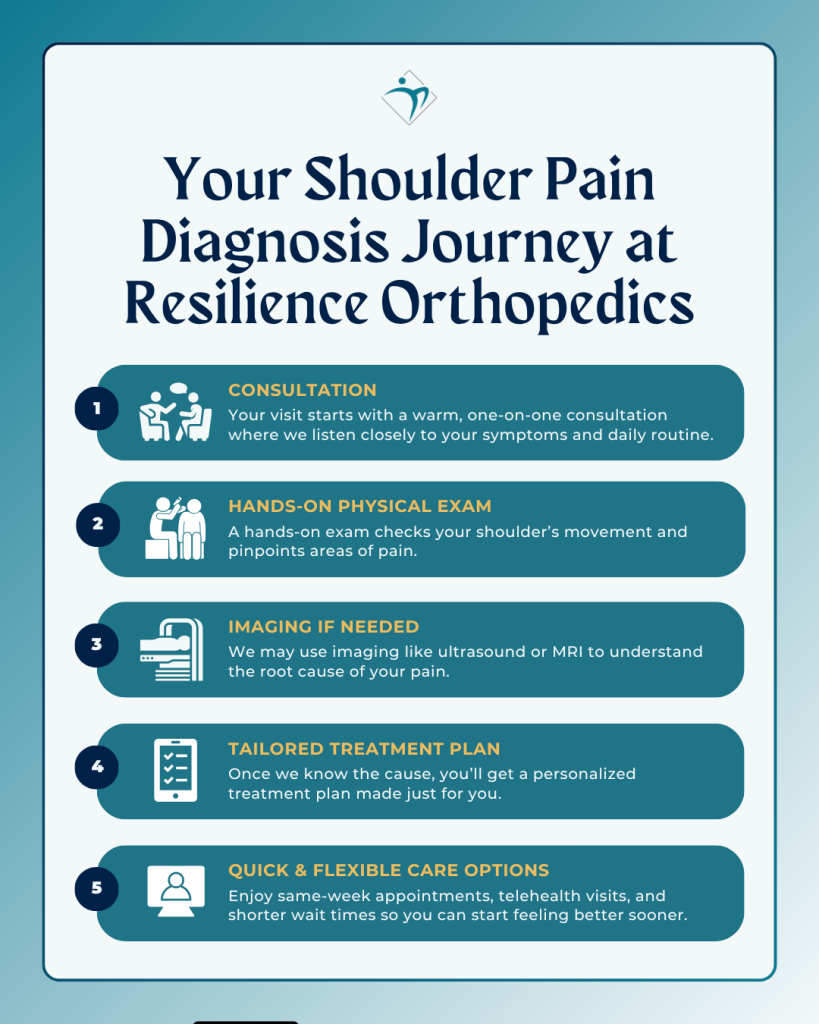
How to Treat Shoulder Bursitis
Even simple tasks can become challenging if your shoulder feels stiff and sore. However, shoulder bursitis usually improves with the right care.
At Resilience Orthopedics, every treatment plan is tailored to your symptoms, lifestyle, and stage of healing.
Non-surgical Treatment
We begin with gentle, non-invasive options to ease pain and inflammation:
- Rest and ice to soothe the bursa and prevent strain.
- Gentle movement to keep the joint from stiffening.
- Anti-inflammatory medications for swelling and daily relief.
- Cortisone injections if pain persists or limits movement. But these are used carefully to avoid tissue damage.
- Physical therapy to rebuild strength, flexibility, and control with expert guidance.

Surgery (If Needed)
Most people won’t need surgery for shoulder bursitis. If the pain continues despite rest, rehabilitation, and injections, surgery may be considered.
Shoulder surgery is an option for chronic bursitis that doesn’t respond to non-surgical treatments. It may also be needed if there is an underlying issue, such as a bone spur or impingement.
At Resilience Orthopedics, surgery is never rushed. I carefully explore every other option first and recommend surgery only if it offers the best path to healing.
What Happens If Shoulder Bursitis Is Left Untreated?
It is easy to brush off shoulder pain, especially if it comes and goes. But over time, it can affect how you move and feel daily.
Here’s what might happen:
- Simple tasks like reaching, lifting, or getting dressed become harder
- Stiffness increases, making your shoulder feel tight
- Muscles around the joint may weaken.
- Sleeping becomes difficult if lying on the sore side
- Posture may suffer if you start favoring one side
- Recovery may take longer if you delay care
- You may lose confidence in movements, especially overhead or repetitive ones
Preventing Shoulder Bursitis Recurrence
Here are a few tips to help prevent bursitis from coming back:
- Raise your screen to your eye-level and use armrests to ease everyday strain.
- Keep proper form during workouts or sports to reduce shoulder pressure.
- Do strengthening and mobility exercises to support the joint and improve flexibility.
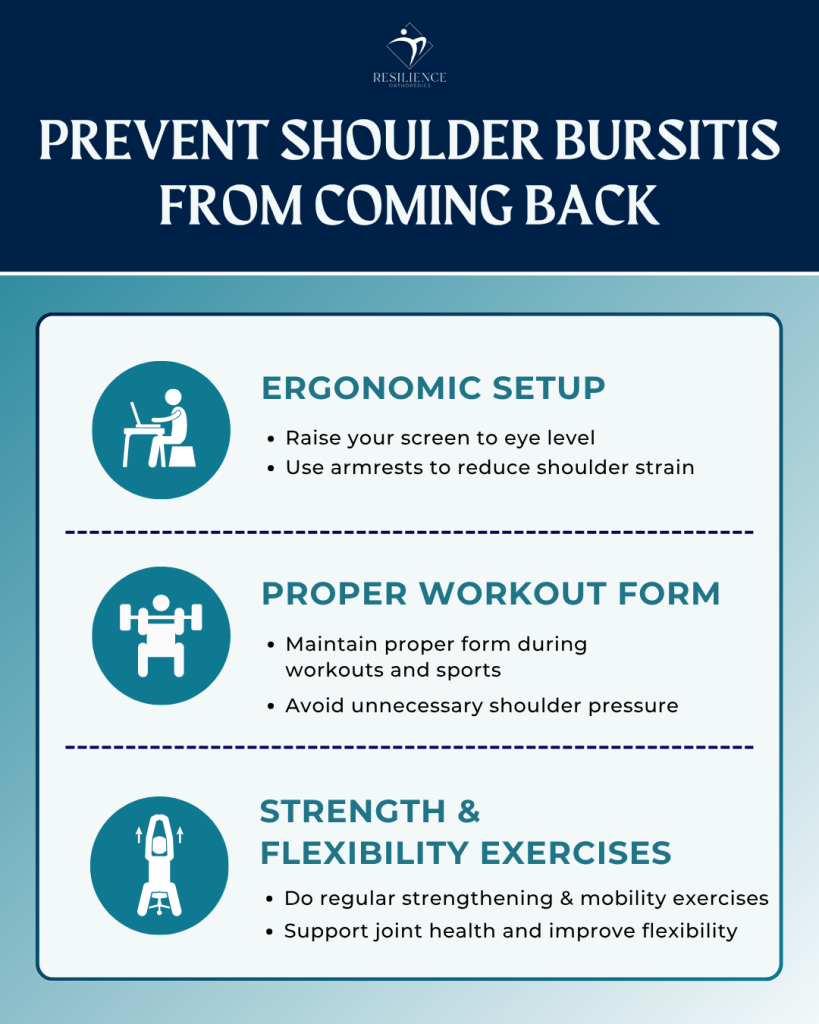
Expert Shoulder Care at Resilience Orthopedics in San Jose
Shoulder pain often builds gradually from daily activities, not just sudden injury. As a board-certified orthopedic surgeon, I take a personalized approach to find the true cause of your pain and create a treatment plan tailored to your life.
At my San Jose clinic, you won’t have to wait long like in larger hospitals. I offer same-week consultations, fast on-site imaging, and care that moves at your pace. I aim to help you regain comfort, strength, and confidence in your shoulder.
Don’t let shoulder bursitis hold you back any longer. Early treatment makes a big difference.
When you’re ready, I’m here to help you move forward with less pain and more ease. Book your consultation today.
Ready to Recover?
Take the first step in getting back to your normal self, and book an appointment with Dr. Mehta today.
We’re ready when you are!

